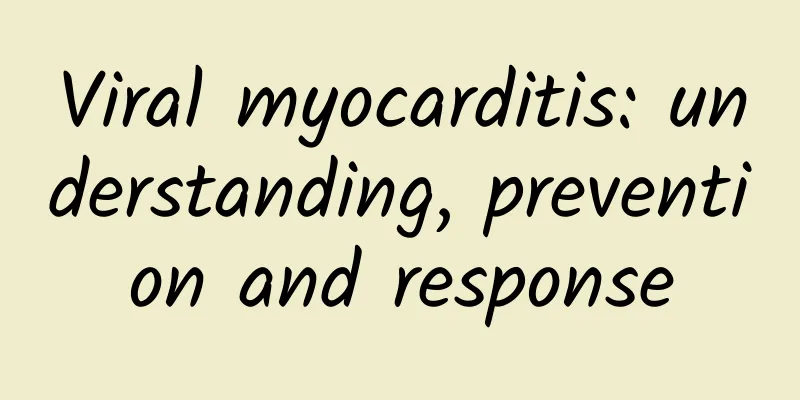Viral myocarditis: understanding, prevention and response

|
1. The wonderful journey of viral myocarditis Imagine that viral myocarditis (VMC) is like an "uninvited guest" party for the heart. It is caused by infectious viruses (especially Coxsackie B) sneaking into the heart, causing a "myocardial carnival" - localized or diffuse acute or chronic myocardial inflammatory lesions in the heart. The lesions may involve the pericardium or endocardium, causing your body to send out "help signals" such as chest tightness, palpitations, and dyspnea. Although it affects people of all ages, children and young adults are its "VIP guests". Image source: Pixabay 2. Fantasy paths of virus invasion and smart defense (1) Droplet exploration: Virus carriers launch "virus missiles" through coughing, sneezing, etc., drawing "invisible tracks" in the air. If you are hit, you become the next target of the virus. Therefore, during the flu season or the peak period of myocarditis, don't forget to wear a mask, maintain social distance, and don't let the virus find you! (2) Close contact: Viruses are "social masters" and like to "visit" another person's mouth, nose, eyes and other mucous membranes through handshakes, shared tableware, etc. Therefore, everyone must maintain good personal hygiene habits; such as washing hands frequently to prevent viruses from having the opportunity to "enter the house"; and do not spit anywhere, or the virus will laugh at you for being "uncivilized"! Image source: Pixabay (3) Maternal-fetal travel: Viruses are also "time travelers" and can play a "prank" on newborns through the placenta or birth canal - neonatal viral myocarditis. Therefore, special attention should be paid to preventing viral infection during pregnancy, and regular prenatal examinations should be performed to ensure that the virus has nowhere to hide! (4) Blood: Viruses also like to travel through blood transfusions, blood products, or unclean syringes. During the medical process, the principle of aseptic operation must be kept in mind to prevent viruses from "taking advantage of the opportunity"! (5) Digestive tract adventure: The virus can also give you a "taste bud challenge" through contaminated food and water sources. Therefore, avoid eating unclean food and drinking raw water, so that the virus will be "deep in despair" in front of delicious food! 3. The “double life” of viral myocarditis (1) Symptoms: The clinical manifestations of viral myocarditis patients depend on the extent and location of the lesions. Mild cases may be completely asymptomatic, while severe cases may even experience cardiogenic shock and sudden death. Before the onset of the disease, most patients may experience a "viral prelude" - prodromal symptoms of viral infection, such as fever, general fatigue, muscle aches, or gastrointestinal symptoms such as nausea and vomiting. This may be followed by palpitations, chest pain, dyspnea, edema, and even syncope and sudden death. The vast majority of clinically diagnosed viral myocarditis are characterized by arrhythmias as the main complaint or first symptom, and a few may experience syncope or Adams-Stokes syndrome. (2) Signs: When the doctor examines you, he or she may find that your heart is "dancing", with atrial and ventricular premature contractions, atrioventricular block and other arrhythmias. The heart rate may increase and be disproportionate to the body temperature. Auscultation may reveal the third and fourth heart sounds or gallop rhythm. Some patients may hear a systolic murmur at the apex. Patients with heart failure may have signs such as distended neck veins, moist rales in the lungs, and enlarged liver. In severe cases, signs of cardiogenic shock such as low blood pressure and cold limbs may appear, which is really "frightening"! 4. Prevention strategies for viral myocarditis (1) Vaccine protection: Getting the flu vaccine and other vaccines for viral diseases is like putting on a layer of "protective clothing" for your body, making it impossible for the virus to attack, thus greatly reducing the risk of viral myocarditis. (2) Hygiene tips: Wash your hands frequently to prevent the virus from "lurking" in your mouth, nose and other parts of your body through your hands; avoid contact with patients and reduce "close contact" with virus carriers; keep your living environment clean so that the virus has nowhere to hide. In this way, you can become a "virus insulator"! (3) Intelligently prevent viruses and live a healthy life: Maintain a balanced diet and take in various nutrients to make your body "iron wall". Regular exercise and appropriate exercise are like "cheer up" for your body, but be careful not to overdo it! Get enough sleep to let your body get enough rest and recovery, so that you can maintain abundant energy and immunity, and make the virus daunting! Contributor: Chongqing Science Writers Association Author: Chongqing Fuling District Center for Disease Control and Prevention, Chief Inspection Technician Ju Danfeng Review Expert: Li Hanbin Statement: Except for original content and special instructions, some pictures are from the Internet, for non-commercial purposes, and are only used as popular science materials. The copyright belongs to the original author. If there is any infringement, please contact us to delete it. |
>>: Beware! Children's eyes are facing these "challenges" during the final exam season
Recommend
Effects of zoledronic acid
Zoledronic acid is used in daily life to help peo...
Popular games promote the popularization of 5G hardware and promote the large-scale application of VR industry
According to Greenlight Insights' forecast, t...
Consequences of acupuncture during menstruation
There is a menarche every month, and there are ma...
What is the best food for luteinized follicles?
The treatment of luteinized follicles needs to be...
How can you spend the New Year in good health? It is important to do the following things
The Chinese New Year is coming soon, and it is in...
Is it OK to eat watermelon when you are eight months pregnant?
During pregnancy, pregnant women have to pay atte...
Symptoms of insufficient heart yin in women
What is heart yin deficiency? Insufficiency of he...
How to remove the IUD? The correct way to remove the ring
There are some things to pay attention to when in...
Can I eat maltose during menstruation?
Many female friends have suggested eating more sw...
The best time for women to maintain health
Health preservation is the choice of many people ...
Moist and profuse vulvar discharge
Every woman's lower body will secrete some su...
How to do hysterosalpingography
Hysterosalpingography is a common gynecological e...
If you suddenly suffer a myocardial infarction at home, what can you do to save yourself correctly?
Many people think that summer is the "off-se...
Female gynecological diseases
There are many types of diseases that women are p...









